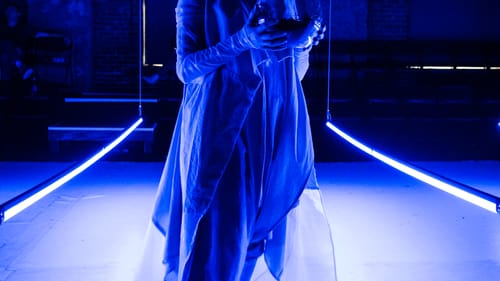Stay in the Loop
BSR publishes on a weekly schedule, with an email newsletter every Wednesday and Thursday morning. There’s no paywall, and subscribing is always free.
The bubble in the glass of God
The Crossing presents ‘Aniara’

Exploring space and time artistically and literally, The Crossing added the enigmatic, melismatic, and visually stunning Aniara to its repertoire in June.
This 90-minute work of performance art (what The Crossing calls “choral theatre”) is the tale of a voyaging vessel and its passengers traveling into infinity. It was shoehorned into the fourth-floor space of Christ Church Neighborhood House, which the audience entered via alley-like North American Street behind the church’s graveyard. It's apt for a work that (like Old City) merges past and present, facing the future.
Seeking a new universe
This world premiere is based on Aniara: A Review of Man in Time and Space, the 103-canto epic poem by celebrated prolific Swedish author Harry Martinson (1904-1978). Written in 1956, Aniara has been twice translated into English (once by the poet Hugh MacDiarmid), adapted into a 1959 electronic opera by Karl-Birger Blomdahl, and made into a 1960 Swedish film. Martinson was awarded a Nobel Prize (1974) for “writings that catch the dewdrop and reflect the cosmos.”
That’s a perfect description of this 17-movement adaptation, which ranges from the cosmic into the intimacy of loss and grief. After leaving a dying Earth (here called Maa), the massive golonder (space ship) Aniara seeks a new universe. But an accident veers it off course, heading eternally into the void. The ship’s 8,000 passengers (the 16 singers of The Crossing) vacillate between hope and grief, seeking first answers to their plight and then comfort as their fate becomes clear.
The birth of Aniara
A complex artistic undertaking, Aniara had a number of creative partners: Donald Nally (The Crossing’s always-voyaging artistic director, who here conducted four instrumentalists as well as the choir); Robert Maggio (West Chester University’s well-known composer and theatrical collaborator who wrote the music); Antti Silvennoinen of Wusheng Company (a Peking Opera troupe from Helsinki, Finland); and stage director/librettist Dan Henriksson. Henriksson is artistic director of the Finnish theatre Klockrike, a nomadic troupe whose motto is the Nobel comment about Martinson.
From breath to breathtaking
The singers entered in silence to the sound of their breathing, after which they sung Maggio’s elegiac “Relief to Forget.” In the adaptation’s prologue and epilogue—and throughout the evening—accomplished Finnish actors Carl Alm (The Narrator) and Matti Raita (Mimaroben, the ship’s engineer) served as guides. They spoke alternately in Finnish and English—sometimes monologues, sometimes in iambic pentameter, sometimes in blank verse—often hauntingly echoing Maggio’s sung passages, especially evocative in Movement 10, “Lamentation,” the work’s musical centerpiece.

The enigmatic, mesmeric Mima (who appeared in Movement 6) is a futuristic artificial intelligence, a robot with a soul. The character was thrillingly danced by Silvennoinen, beginning with a breathtaking, gravity-defying Peking-opera tour-de-force that morphed into a tentative exploration of reality as s/he faded away. Silvennoinen also choreographed the ensemble, employing elements of Peking-opera style to inform the way that the performers walk, move, and handle props.
Necessary surrender
Designer Erika Turunen’s all-white, intricately constructed tunics and embellished capes (with a beautiful textile surprise at the end) set a futuristic tone. The costumes and an all-white fabric floor were a canvas (literally) for the evanescent, inspired lighting and video design of Finnish theater artist Joonas Tikkanen. His stunning universe of visual, emotive effects ranged from anxiety-producing patterns reminiscent of early black-and-white television to sweeping, colorful earth-space vistas and bowls of glass set in circles of dancing light.
Grounded in choral tradition and with its impeccable technique, The Crossing always explores new musical ground. Aniara is a step further for the singers, and this production also marks their European debut: they travel in early July to the Haarlem Choral Biennale in the Netherlands and to Helsinki in mid-September to perform at the Finnish National Opera. An intimate venue like Neighborhood House does not perfectly serve this production, so it will be revealing for this work to be in venues that allow breathing room for both singers and the show’s arresting visual sweep.
Surrender—that’s what performance art demands of performers and audience. Even in a work with a storytelling arc like this one, both creators and viewers must surrender to the nonlinear, nonnarrative universe in which they are temporarily locked. Like relativity, here the rate at which time passes depends on the object’s velocity relative to the observer. After a quarter-hour of speculation and adaptation, the audience got on board, and the stunning voyage of Aniara took flight.
What, When, Where
Aniara: fragments of time and space. Conceived and produced by Donald Nally, Robert Maggio, and Dan Henriksson. The Crossing. June 20, 2019, at Christ Church Neighborhood House, 20 North American Street, Philadelphia. crossingchoir.org.
Christ Church Neighborhood House has ADA-compliant restrooms and an elevator to the fourth-floor performance space, though the surrounding neighborhood streets can be challenging. There is floor-level seating available.
Sign up for our newsletter
All of the week's new articles, all in one place. Sign up for the free weekly BSR newsletters, and don't miss a conversation.

 Gail Obenreder
Gail Obenreder